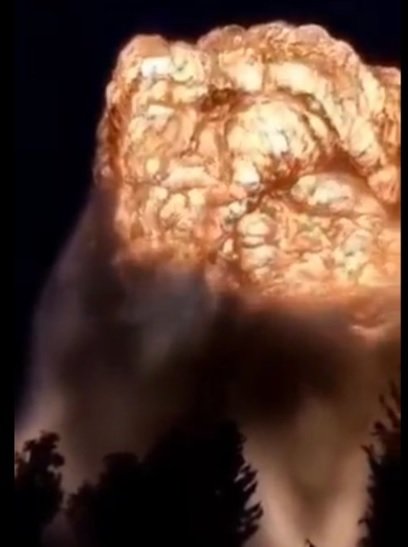As a huge ‘mushroom cloud’ soared over Gomelnytsky, western Ukraine, where a large-scale explosion occurred due to a Russian drone strike, concerns are being raised about the leakage of radioactivity due to the explosion of ‘depleted uranium bombs’.
According to reports such as Newsweek on the 15th (local time), a large explosion occurred at the Ukrainian army ammunition depot in Gomelnytsky on the 13th, and a huge ‘mushroom cloud’ soared into the sky. There are suspicions that this may have happened.
During an air raid by a Russian self-destruct drone, two explosions occurred in the ammunition depot, and afterward, some civilian military experts and pro-Russian media argued that a depleted uranium bomb in the ammunition depot exploded and leaked radioactivity to the area.
It was around 3:05 in the morning at the time. After a loud explosion shortly after the air raid alert was sounded, four Russian drones struck a local military installation and set off an explosion, damaging nearby dwellings and other buildings. It is reported that dozens of people were injured.
The remaining 17 drones were shot down by Ukrainian air defenses, local media reported.
Concerns about the leakage of radioactivity are emerging one after another on social media, with videos and photos of the explosion, as well as photos comparing the level of radioactivity thereafter.
Some pro-Russian sources claim that the attack destroyed $2.2 billion or $500 million worth of weapons supplied by NATO. Among them, it is claimed that the depleted uranium bomb supported by the UK exploded and caused a huge mushroom cloud to soar.
 As a huge ‘mushroom cloud’ soared over Gomelnytsky, western Ukraine, where a large-scale explosion occurred due to a Russian drone strike, concerns were raised about the possibility of a ‘depleted uranium bomb leak’, centered on some. twitter capture
As a huge ‘mushroom cloud’ soared over Gomelnytsky, western Ukraine, where a large-scale explosion occurred due to a Russian drone strike, concerns were raised about the possibility of a ‘depleted uranium bomb leak’, centered on some. twitter capture◇ As concerns grow, organizations affiliated with the EU present comparison and analysis of radiation levels
Ihor Moshchuk, a former member of the Radical Party, a right-wing nationalist party in Ukraine, also hinted at the possibility of a radioactive leak the day before, saying, “There was a depleted uranium bomb in the Khmelnytsky ammunition depot.”
As concerns escalated, the Center for Strategic Communications and Information Security (SPRAVDI) under the Ukrainian Armed Forces defined it as “fake news” and denied it outright.
Authorities said, “After the explosion on the 13th, Russian propagandists wrote about 200 messages on Telegram about the radiation leak, of which 50 were in Russian. However, these are all lies.” Then he wrote that it was a typical lie of Russia.
In addition, to confirm this claim, based on the data of the Joint Research Center (JRC), an advisory body of the European Union (EU), on the global radiation map, the spatial gamma dose rate (radiation dose rate in the living environment) per hour before and after the Russian air strike was confirmed and announced.
The spatial gamma dose rate per hour is a unit that measures the amount of gamma rays generated by radioactive materials in a certain space, and is recognized as a value that normally exists in nature up to 0.3nSv/h.
According to Ukrainian and Western civilian military experts, it was on the 11th, before the airstrike, that radiation levels in the 20 km area around Khmelnytsky increased for the first time.
 As a huge ‘mushroom cloud’ soared over Gomelnytsky, western Ukraine, where a large-scale explosion occurred due to a Russian drone strike, concerns were raised about the possibility of a ‘depleted uranium bomb leak’, centered on some. twitter capture
As a huge ‘mushroom cloud’ soared over Gomelnytsky, western Ukraine, where a large-scale explosion occurred due to a Russian drone strike, concerns were raised about the possibility of a ‘depleted uranium bomb leak’, centered on some. twitter capture◇ Ukrainian authorities deny the suspicion, “The real nuclear threat is Russia itself”
The radiation dose increased to more than 145nSv/h on the 11th and 12th days and decreased to less than 125nSv/h on the 13th. However, on the 14th, after the air raid, the radiation dose soared to over 155 μSv/h. Although the amount increased, it returned to the original level within a day, making it difficult to determine whether radiation was leaked, analysts say.
Ukrainian authorities have repeatedly stressed that radiation levels did not exceed the standard and that depleted uranium bombs are neither nuclear weapons nor dangerous materials.
“The real nuclear threat is not depleted uranium bombs, but Russia itself.”
Ukraine’s state-owned nuclear power plant operator, Ergo Atom, also denied the allegations, saying, “There is no evidence that radiation levels in the Khmelnytsky region have increased, and the levels in the area are within the naturally occurring range.”
Meanwhile, depleted uranium bombs refer to tank shells made with depleted uranium generated in the process of enriching uranium as a warhead.
In March, Britain announced support for depleted uranium bombs along with its main battle tank, the Challenger 2 tank.
The depleted uranium component itself is highly chemically toxic and is known to be toxic enough to contaminate soil and groundwater.
Source: Donga
Mark Jones is a world traveler and journalist for News Rebeat. With a curious mind and a love of adventure, Mark brings a unique perspective to the latest global events and provides in-depth and thought-provoking coverage of the world at large.